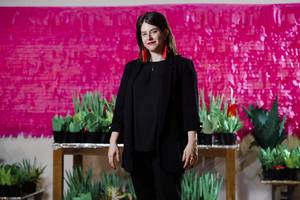Alisha Kerlin holds up a white 3D print of a 2,000-year-old Mesoamerican animal sculpture like a proud mom at a soccer game. “I have a very intimate relationship with this collection,” she beams. For the duration of our museum tour, she carries the replica around, clutching it under her arm like a football. “I didn’t realize his toe was broken,” she says, as if she should have traveled back in time 2 millennia to stop the damage. If she could, she would.
The amount of love Kerlin has for that Mesoamerican statue replica? That’s only a tiny fraction of the passion she has for UNLV’s Barrick Museum. As executive director, she’s not just the museum’s biggest advocate, she’s also its No. 1 fan. For a little more than two years, Kerlin served as interim director of the museum while the university conducted a nationwide search for a permanent one. During that time, Kerlin officially oversaw the museum’s name change, from the Marjorie Barrick Museum of Natural History to the Marjorie Barrick Museum of Art. She instituted the Bus to the Barrick program, which provides buses to K-12 schools in the Valley so students can visit and tour a real art museum—most of them doing so for the first time. And she has ushered in a cultural shift, focusing on the perspectives of people of color, women and LGBTQ communities.
“I thought, well, if I’m in charge and my supervisor is giving me responsibility and trusting me with this space, I’m going to make some changes,” Kerlin said of that interim role. “Sometimes I look back on that [time] from 2016 to now, and it’s insane what we’ve done.”
Kerlin moved from New York City to Las Vegas in 2012 as an artist-in-residence at UNLV. Instead of returning to her successful career as a painter in New York, she stayed, working as assistant curator, collections manager and office manager at the Barrick for four years.
“The city was hard for me to understand, and I liked that,” she says. Just a year prior, the Barrick lost state funding and was faced with closure, but was saved when it joined forces with the College of Fine Arts. Kerlin found new passion in the museum, refurbished and now housing a permanent collection of artifacts. “We started taking inventory of our collection and there was an imbalance—mostly white men in the collection,” Kerlin says. “So we were trying to balance that.”
And she is. 2018’s Jubilation Inflation by Tamar Ettun was the museum’s first solo exhibition by a woman since Rita Deanin Abbey in the late 1980s, and January’s Axis Mundo marked the first time the museum offered both Spanish and English text on the walls. It’s something Kerlin wants to make standard.
“I feel like it’s a responsibility to pass the mic,” she says. “UNLV is really proud of being the most diverse university. If that’s who we are, then I find it really important to serve those students. We had incredible feedback with Axis Mundo, [people saying], ‘For 14 years I didn’t feel welcome at this museum and now I do.’ I need to work harder when I hear that.”







